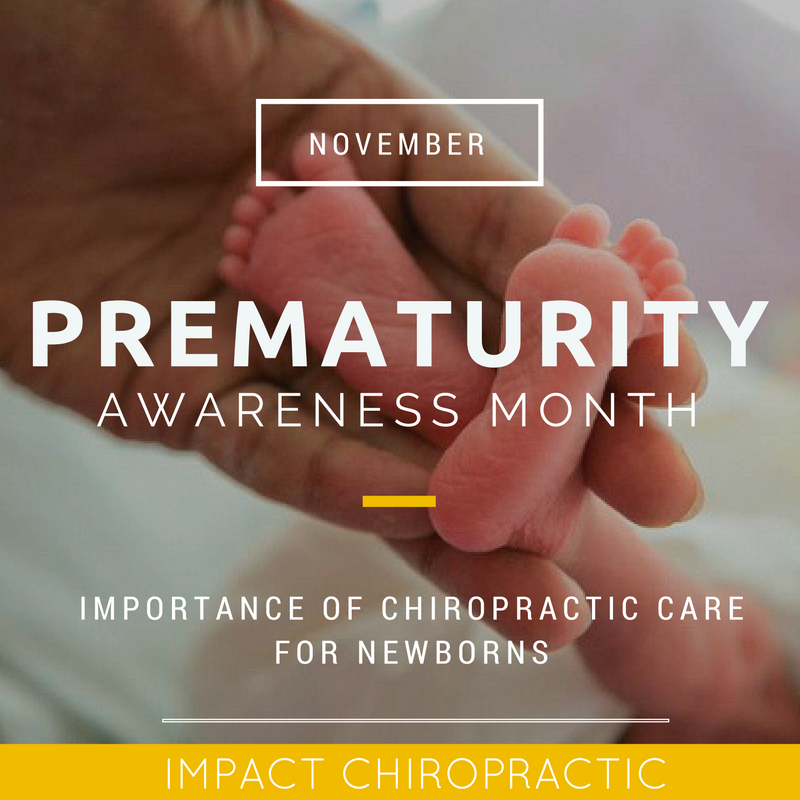November 17th kicks off Prematurity Awareness Month and at Impact Chiropractic, we see many premature and full-term babies. Although premature delivery is not always preventable, there are steps parents can take to make sure their little ones thrive right from birth.

Our hospitals provide wonderful care in the NICU, but what about the life of these preemie babies after they leave there? Premature babies are at greater risk of breathing difficulties, feeding, digestion, and brain development. When infants stay in the NICU longer, the areas they work on are supporting vital organ development, such as brain, lung and gastrointestinal functions. Physical manifestations of prematurity are easily seen and well understood, but the neurological development is hard to study and difficult to tell until they are school age kiddos.
Research shows that 40% of premature babies develop mild motor impairments such as fine motor skills (tasks such as doing puzzles or holding pencils), motor planning (seeing an object on the floor and walking around it), visuomotor coordination (writing and drawing) and sensorimotor skills (feeling the weight of an object and successfully handling it). Preemies struggle with GERD and reflux. It also shows that language development can be delayed. Attention and behavioral deficits, such as learning disabilities and ADHD, also exist in these kiddos.
Another research study looked at “5-year- olds born between 1996 and 1997 with birth weights of less than 1,000 grams, 51 percent had coordination problems, 18 to 20 percent had abnormal reflexes or abnormal posture, and 17 percent had exceptional involuntary movements (1). Sensorimotor integration problems can range from inability to tolerate certain textures of food or clothing (e.g., an inability to tolerate lumpy food or the tag on the back of a T-shirt) to difficulty following demonstrated directions (e.g., how to put on a shirt or tie shoelaces) or an inability to tolerate motion (e.g., swinging).
These tasks include drawing, cutting with scissors, dressing, writing, copying figures, perceptual mapping, spatial processing, finger tapping, and pegboard performance. As with other neurodevelopmental disabilities and school problems, the prevalence of learning disabilities increases with decreasing gestational age and birth weight: 7 to 18 percent in children born full term, 30 to 38 percent in children born with birth weights 750 to 1,499 grams, 66 percent in children born at less than 28 weeks of gestation, and 50 to 63 percent in children born with birth weights less than 750 grams.
Work also needs to be done to develop treatment strategies that prevent injury to the brain and other organs and support the infant’s ongoing development.” (2) This research article notes the problems that revolve around premature births, but at the time they were unsure about how to resolve these issues. Another study looked at the difference in living environments of premature infants when they go from the mother’s womb to a bed in the NICU. When premature babies are in the NICU, they tend to be stationary and lying flat on their backs in the beds. This increased time spent lying flat increases the likelihood of deformational plagiocephaly (flattening of the skull bones) which in turn leads to neurodevelopment disadvantages.(3) This, along with the birth process, can cause problems to the developing nervous system.
As chiropractors, we find cranial and/or vertebral misalignments and gently restore them to their proper position, with no adverse side effects. Chiropractic adjustments allow the brain to communicate with the rest of the body, and the body sends proper signals back up to the brain. This is how adjustments can help with motor tasks and also helps with learning difficulties. When it comes to GERD, premature babies have an incompetent lower esophageal sphincter. The problem with this sphincter causes reflux, spit up, fussy and colicky babies. Chiropractors can help the nerves wire to that organ, so the sphincter can work as soon as possible and gastric acid doesn’t flow into the esophagus.
Let your local pediatric chiropractor help your little one. If you have any questions about chiro care, let us know. We’d love to help give your child the best life possible.
1. Mikkola: Mikkola K, Ritari N, Tommiska V, Salokorpi T, Lehtonen L, Tammela O, Paakkonen L, Olsen P, Korkma, Fellman V. for the Finnish ELBW Cohort Study Group. Neurodevelopmental outcome at 5 years of age of a National Cohort of extremely low birth weight infants who were born in 1996-1997. Pediatrics. 2005;116(6):1391–1400. [PubMed] [Reference list]
2. (Institute of Medicine (US) Committee on Understanding Premature Birth and Assuring Healthy Outcomes; Behrman RE, Butler AS, editors. Preterm Birth: Causes, Consequences, and Prevention. Washington (DC): National Academies Press (US); 2007. 11, Neurodevelopmental, Health, and Family Outcomes for Infants Born Preterm. Available from: https://www.ncbi.nlm.nih.gov/books/NBK11356/)
3. Improvement in prematurity outcome- A chiropractic case report Carmel Therese Whelan, DICCP. Journal of Clinical Chiropractic Pediatrics, Volume 14, March 2014.

